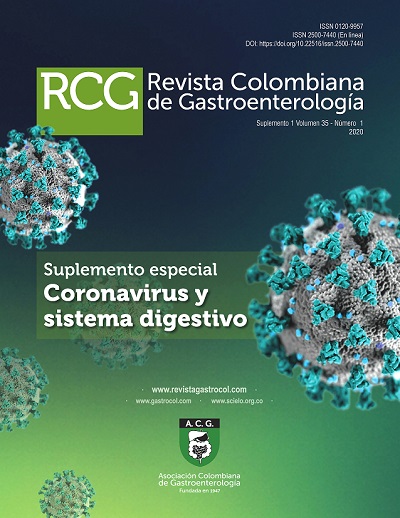Manifestaciones gastrointestinales de la infección por el "Nuevo Coronavirus"
DOI:
https://doi.org/10.22516/25007440.541Palabras clave:
COVID 19, manifestaciones gastrointestinales, transmisión fecal oralResumen
El 11 de marzo del 2020 la Organización Mundial de la Salud (OMS) declaró la pandemia por el brote de la enfermedad por coronavirus 2019 (COVID-19). Los primeros datos acerca de las manifestaciones clínicas provienen de estudios retrospectivos de Wuhan, China, epicentro de la pandemia; además del compromiso respiratorio, se ha descrito la afectación del sistema gastrointestinal. Aunque no está del todo claro el porqué del tropismo de COVID-19 por el tracto gastrointestinal, se ha demostrado que la enzima convertidora de angiotensina 2 (ECA2), la cual tiene una alta expresión en el sistema gastrointestinal, es empleada como receptor de entrada del virus. Se ha logrado documentar la posibilidad de trasmisión fecal-oral luego de demostrar la existencia del virus en las heces, incluso hasta dentro de 7-12 días después de la conversión negativa en la muestra faríngea, independientemente de la presencia o no de síntomas gastrointestinales. La afectación del sistema gastrointestinal en pacientes con infección por COVID-19 no es infrecuente; los datos reportan que los pacientes con síntomas gastrointestinales tienen un peor pronóstico. El conocimiento de estas manifestaciones nos permite aumentar la sospecha clínica y, de esta manera, establecer diagnósticos tempranos.
Descargas
Referencias bibliográficas
Organización Mundial de la Salud. Alocución de apertura del Director General de la OMS en la rueda de prensa sobre la COVID-19 celebrada el 11 de marzo de 2020. https://www.who.int/es/dg/speeches/detail/who-director-general-s-opening-remarks-at-the-media-briefing-on-covid-19---11-march-2020
Center for Systems Science and Engineering (CSSE) at Johns Hopkins University (JHU) [Internet]. COVID-19 Dashboard by the Center for Systems Science and Engineering (CSSE) at Johns Hopkins University (JHU). Disponible en: https://gisanddata.maps.arcgis.com/apps/opsdashboard/index.html#/bda7594740fd40299423467b48e9ecf6/
Instituto Nacional de Salud [Internet]. INS; 2020 [acceso 1 de mayo de 2020]. Informe Coronavirus. Disponible en: https://www.ins.gov.co/Noticias/Paginas/Coronavirus.aspx
Gao QY, Chen YX, Fang JY. 2019 Novel coronavirus infection and gastrointestinal tract. J Dig Dis. 2020;21(3):125-6. https://doi.org/10.1111/1751-2980.12851
Tian Y, Rong L, Nian W, He Y. Review article: gastrointestinal features in COVID-19 and the possibility of faecal transmission. Aliment Pharmacol Ther. 2020;51(9):843-51. https://doi.org/10.1111/apt.15731
Cheung KS, Hung IFN, Chan PPY, Lung KC, Tso E, Liu R, et al. Gastrointestinal Manifestations of SARS-CoV-2 Infection and Virus Load in Fecal Samples from the Hong Kong Cohort and Systematic Review and Meta-analysis. Gastroenterology. 2020;S0016508520304480. https://doi.org/10.1053/j.gastro.2020.03.065
Musa S. Hepatic and gastrointestinal involvement in coronavirus disease 2019 (COVID-19): What do we know till now? Arab J Gastroenterol. 2020. https://doi.org/10.1016/j.ajg.2020.03.002
Leung WK, To K, Chan PKS, Chan HLY, Wu AKL, Lee N, et al. Enteric involvement of severe acute respiratory syndrome-associated coronavirus infection. Gastroenterology. 2003;125(4):1011-7. https://doi.org/10.1016/S0016-5085(03)01215-0
Guan W, Ni Z, Hu Y, Liang W, Ou C, He J, et al. Clinical Characteristics of Coronavirus Disease 2019 in China. N Engl J Med. 2020. https://doi.org/10.1056/NEJMoa2002032
Lee I-C, Huo T-I, Huang Y-H. Gastrointestinal and Liver Manifestations in Patients with COVID-19: J Chin Med Assoc. 2020. https://doi.org/10.1097/JCMA.0000000000000319
Song Y, Liu P, Shi XL, Chu YL, Zhang J, Xia J, et al. SARS-CoV-2 induced diarrhoea as onset symptom in patient with COVID-19. Gut. 2020. https://doi.org/10.1136/gutjnl-2020-320891
Chen N, Zhou M, Dong X, Qu J, Gong F, Han Y, et al. Epidemiological and clinical characteristics of 99 cases of 2019 novel coronavirus pneumonia in Wuhan, China: a descriptive study. The Lancet. 2020;395(10223):507-13. https://doi.org/10.1016/S0140-6736(20)30211-7
Li G, Fan Y, Lai Y, Han T, Li Z, Zhou P, et al. Coronavirus infections and immune responses. J Med Virol. 2020;92(4):424-32. https://doi.org/10.1002/jmv.25685
Cai Q, Huang D, Yu H, Zhu Z, Xia Z, Su Y, et al. Characteristics of Liver Tests in COVID-19 Patients. J Hepatol. 2020. https://doi.org/10.1016/j.jhep.2020.04.006
Li J, Fan J-G. Characteristics and Mechanism of Liver Injury in 2019 Coronavirus Disease. J Clin Transl Hepatol. 2020;8(1):1-5. https://doi.org/10.14218/JCTH.2020.00019
Fan Z, Chen L, Li J, Tian C, Zhang Y, Huang S, et al. Clinical Features of COVID-19 Related Liver Damage. Gastroenterology. 2020. https://doi.org/10.1101/2020.02.26.20026971
Liu F, Long X, Zou W, Fang M, Wu W, Li W, et al. Highly ACE2 Expression in Pancreas May Cause Pancreas Damage After SARS-CoV-2 Infection. Infectious Diseases (except HIV/AIDS). 2020. https://doi.org/10.1101/2020.02.28.20029181
Wang F, Wang H, Fan J, Zhang Y, Wang H, Zhao Q. Pancreatic injury patterns in patients with COVID-19 pneumonia. Gastroenterology. 2020. https://doi.org/10.1053/j.gastro.2020.03.055
Chen Y, Chen L, Deng Q, Zhang G, Wu K, Ni L, et al. The Presence of SARS-CoV-2 RNA in Feces of COVID-19 Patients. J Med Virol. 2020. https://doi.org/10.1002/jmv.25825
Chen L, Lou J, Bai Y, Wang M. COVID-19 Disease With Positive Fecal and Negative Pharyngeal and Sputum Viral Tests: Am J Gastroenterol. 2020. https://doi.org/10.14309/ajg.0000000000000610
Xiao F, Tang M, Zheng X, Liu Y, Li X, Shan H. Evidence for Gastrointestinal Infection of SARS-CoV-2. Gastroenterology. 2020. https://doi.org/10.1053/j.gastro.2020.02.055
Li LY, Wu W, Chen S, Gu JW, Li XL, Song HJ, et al. Digestive system involvement of novel coronavirus infection: prevention and control infection from a gastroenterology perspective. J Dig Dis. 2020. https://doi.org/10.1111/1751-2980.12862
Descargas
Publicado
Cómo citar
Número
Sección
Licencia
Aquellos autores/as que tengan publicaciones con esta revista, aceptan los términos siguientes:
Los autores/as ceden sus derechos de autor y garantizarán a la revista el derecho de primera publicación de su obra, el cuál estará simultáneamente sujeto a la Licencia de reconocimiento de Creative Commons que permite a terceros compartir la obra siempre que se indique su autor y su primera publicación en esta revista.
Los contenidos están protegidos bajo una licencia de Creative Commons Reconocimiento-NoComercial-SinObraDerivada 4.0 Internacional.



















